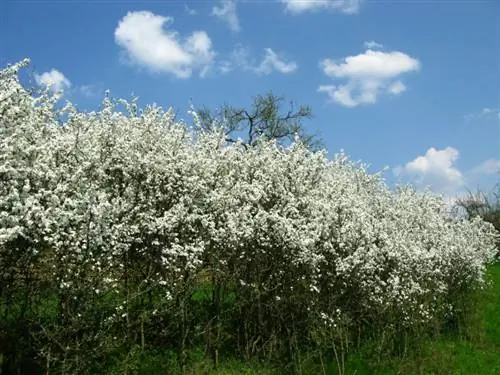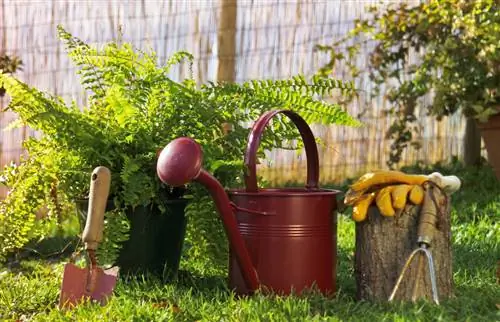- Author admin [email protected].
- Public 2023-12-16 16:46.
- Last modified 2025-01-23 11:21.
If you would like to bring Mediterranean flair to your garden, then the lushly blooming wisteria is not the worst choice. Before planting, however, you should consider that it is very poisonous and may need to take appropriate precautions.

How do you plant wisteria correctly?
To plant wisteria, choose a sunny location and prepare a 60 cm deep planting hole with permeable, nutrient-rich soil. Add some lime and compost, plant the wisteria, water generously and provide a stable climbing aid. Planting in spring is ideal.
The best location for wisteria
As a heat-loving climbing plant, wisteria prefers a sunny location, ideally with protection from strong winds. He also needs a stable climbing aid. Don't let it grow on the rain pipe, over the years your wisteria could dent the pipe. By the way, a wisteria can also be grown as a standard tree.
The right soil for wisteria
The wisteria finds a permeable, nutrient-rich soil with a not too high lime content to be ideal. You should loosen up loamy soil a little by adding sand. If the soil is poor, mixing in well-ripened compost helps.
If your soil is too rich in nitrogen for wisteria, it will grow abundantly but only bloom sparsely. It also becomes susceptible to fungal diseases. In this case, you should avoid nitrogen-rich fertilizer.
Planting tips in brief:
- sunny location
- South wall promotes flowering
- permeable nutrient-rich soil
- Dig a planting hole about 60 cm deep
- work in some lime and compost
- Use wisteria
- pour well
- stable trellis
- planting in spring
- Container plants generally bloom more happily than home-grown ones
Water and fertilize wisteria correctly
During the growth phase and flowering period, your wisteria needs sufficient water and nutrients. If the soil is dry, water regularly to prevent the flowers from falling off. A layer of mulch will help you retain moisture in the soil for longer. Provide the wisteria with a lime-free and low-nitrogen fertilizer about once a month.
Pruning wisteria correctly
Due to its really strong growth, you should definitely prune a wisteria regularly. As a rule, one cut each in summer and winter is recommended. This will keep growth in check and the wisteria will be less susceptible to wind. A radical pruning is then not necessary, although the wisteria survives this quite well.
Diseases and pests of wisteria
With good care and in the right location, wisteria is quite robust. However, if the moisture is persistent and the soil is too nitrogen-rich, it is prone to fungal infestation and chlorosis. The leaves turn yellow and later fall off.
Your wisteria in winter
Wisteria is considered hardy and only needs winter protection in the first few years. If it is protected from cold easterly winds, then its buds are unlikely to freeze; unfortunately, they are sensitive to frost. As a container plant, it is better to overwinter your wisteria frost-free.
Tip
Even if the wisteria is hardy, it enjoys a sunny and warm location.






